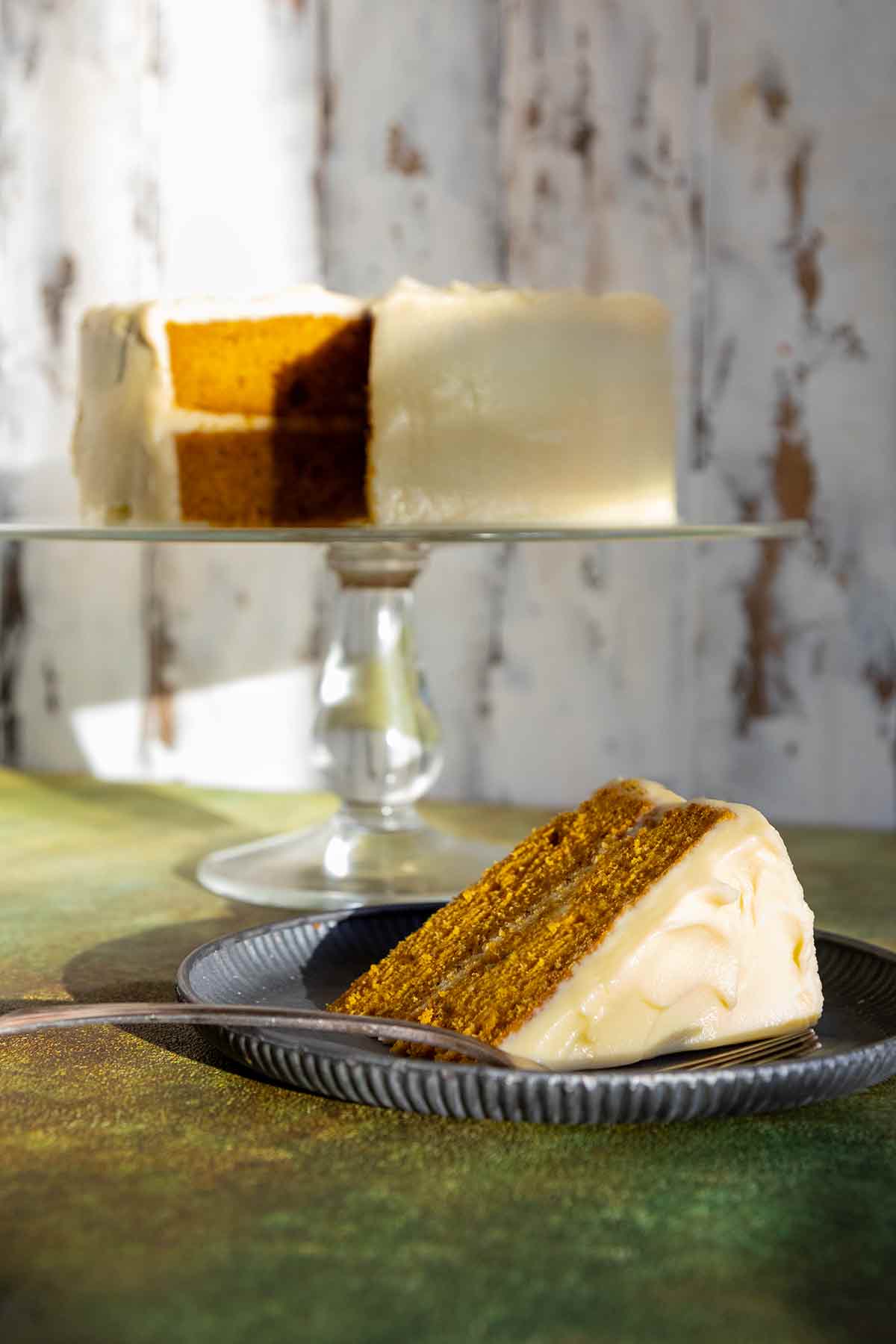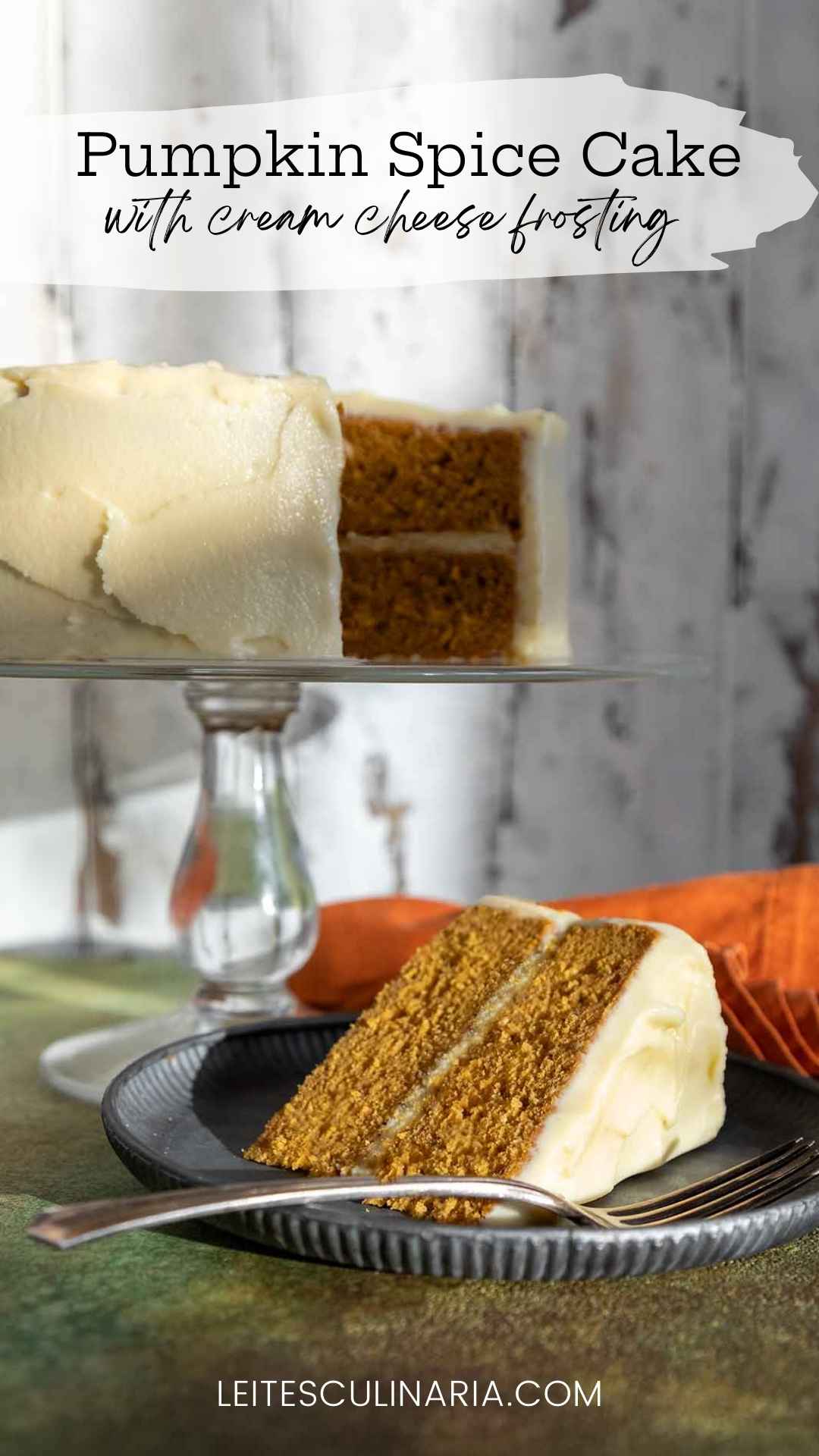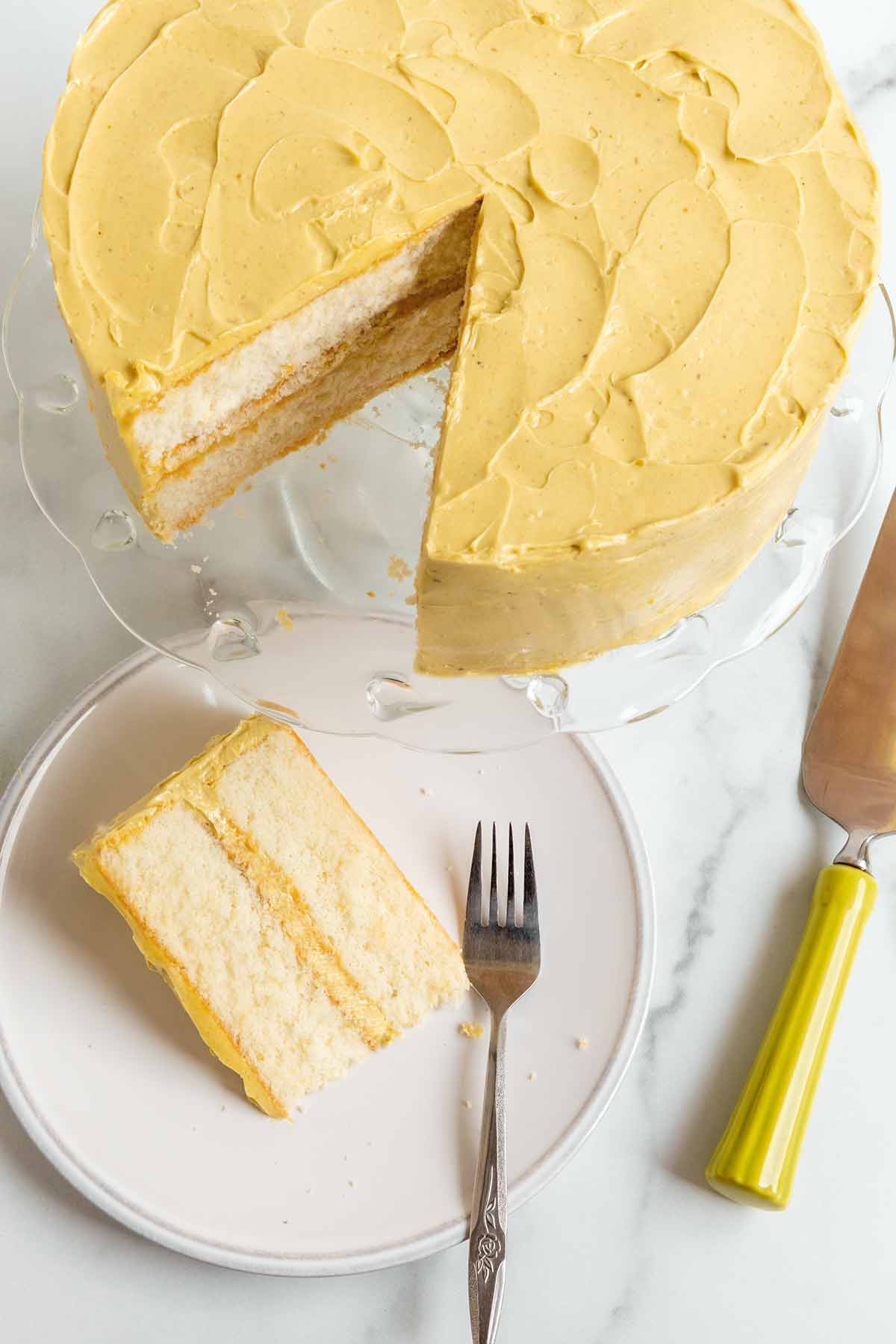
This pumpkin cake, along with its incredible maple cream cheese frosting, is a recipe I developed a long time ago for an article I wrote for the Los Angeles Times about Thanksgiving. I was killing two birds with one stone (forgive the holiday pun) by making my editor as well as The One happy. (The One loves anything pumpkin. This cake has actually beat out his former favorite autumn dessert, pumpkin pie.)
Since then, this recipe has become one of those baked-around-the-Internet desserts, like my ultimate chocolate chip cookies. I’ve seen my cake turned into some really clever loaves, mini-Bundt cakes, and, my favorite, cupcakes. It seems to take well to any form you can think to make it in.
Jump To

Why this Recipe Works
There’s lots of good food science going on here!
The cake flour creates a delicate crumb, while buttermilk provides both tenderness and a subtle tang. The hefty amount of canned pumpkin puree delivers moisture and rich flavor without making the cake brick-heavy.
Dark brown sugar adds molasses notes, while the blend of warm spices—enhanced by a scooch of black pepper—creates complex autumn flavors.
The maple cream cheese frosting perfectly complements these elements, with its tangy-sweet profile and creamy texture balancing the spiced cake. Like my Vovo Costa would say of flavors, “They married well.”
Notes on Ingredients

- Cake flour–The low gluten content of cake flour helps to give this cake a light, airy texture.
- Eggs–Use room-temperature eggs for best results. They are more easily incorporated into the batter than cold eggs and will allow for a better rise in the cake.
- Pumpkin puree–Use canned pumpkin puree (not pumpkin pie filling) for this cake. I don’t recommend using homemade pumpkin puree as it tends to be more watery than canned.
- Cream cheese–Use full-fat cream cheese for best results.
How to Make This Recipe

- Preheat the oven to 350°F. Line two 8-inch cake pans with parchment rounds, then butter and flour the parchment.
- Whisk the dry cake ingredients together in a bowl.

- Combine the butter and sugars in the bowl of a stand mixer fitted with the paddle attachment.
- Beat on medium speed until fluffy.

- Add the eggs one at a time, beating between each addition.
- Scrape down the sides and beat until smooth.

- Add 1/3 of the flour mixture to the bowl, and beat until incorporated.
- Pour in half of the buttermilk, and beat until smooth. Alternate adding the remaining flour and buttermilk to the bowl.

- Stir in the pumpkin until smooth.
- Divide the batter between the two prepared cake pans. Bake until a tester comes out clean.

- To make the frosting, combine the cream cheese, butter, powdered sugar, and maple syrup in the bowl of a stand mixer fitted with the paddle attachment.
- Beat until smooth and fluffy.
- Assemble the layer cake by placing one layer on a plate or cake stand and frosting the top of it. Add the second layer, then frost the top and sides with the remaining frosting.

Pumpkin Cake FAQs
Folks rave about this maple-cream cheese frosting. Rightly so. But it can tend to be a bit on the soft side—as in, perhaps a little too soft if the cake needs to sit out for a few hours in a warm kitchen. (And by “a warm kitchen,” we mean a kitchen in which the Thanksgiving turkey is roasting and all four burners are blasting come Thanksgiving morning.)
1. You can firm it up in the fridge before frosting the cake.
2. Plopping an extra stick of butter also works. The result is a sturdier frosting, with no sacrifice in flavor, that’s able to withstand sitting out for several hours in any climate.
4. If you can get your hands on the darker, more robust maple syrup formerly known as Grade B and recently redesignated as “Grade A Dark Color, Robust Taste,” the frosting magically holds up like a champ and requires no extra butter.
4. You can also mix a bit of the frosting with a tablespoon of cornstarch and beat it into the rest of the frosting.
Yes. Our readers have had success swapping in a gluten-free all-purpose baking blend for the flour. This works best when measured by weight.
The unfrosted pumpkin cake and the maple cream cheese frosting can be frozen separately for up to 3 months. Completely cool the cake layers on a rack, then tightly wrap each in plastic before freezing. Freeze the frosting in an airtight container. Thaw at room temperature before assembling the cake.
Pro Tips
- It’s crucial to use room-temperature ingredients for your frosting to ensure a smooth texture, otherwise, the frosting can be lumpy.
- If the frosting seems soft after you’ve finished spreading it on the cake, pop the cake into the fridge for 30 minutes to let the frosting firm up.
- Store the cake, covered, at room temperature for up to 3 days.

Write a Review
If you make this recipe, or any dish on LC, consider leaving a review, a star rating, and your best photo in the comments below. I love hearing from you.–David
Why You Can Trust Our Recipes
✓ Tested and proven for more than 25 years
✓ Made by 150+ professionals and experienced home cooks
✓ Blind testing process
✓ Only 68% of tested recipes make the cut

Pumpkin Cake With Maple Cream Cheese Frosting
Ingredients
For the pumpkin cake
- 2 cups cake flour, plus more for the pans
- 2 teaspoons baking powder
- 1 teaspoon baking soda
- 1 teaspoon ground cinnamon
- 1 teaspoon ground ginger
- 1/2 teaspoon ground nutmeg
- 1/8 teaspoon ground cloves
- 1/2 teaspoon salt
- 1/4 teaspoon freshly ground black pepper, (I mean freshly ground!)
- 1 stick (4 oz) unsalted butter, at room temperature, plus more for the pans
- 1 cup firmly packed dark brown sugar
- 1/3 cup granulated sugar
- 2 large eggs
- 1/2 cup buttermilk mixed with 1 teaspoon vanilla extract
- 1 1/4 cups canned solid-pack pumpkin
For the maple cream–cheese frosting
- Two (8-ounce) packages Philadelphia brand cream cheese, fully softened
- 1 stick (4 oz) unsalted butter, at room temperature
- 2 cups confectioners’ sugar
- 1/4 cup pure maple syrup, preferably grade B amber
Instructions
Make the pumpkin cake
- Crank the heat to 350° (175°C) and position a rack in the middle of the oven.
- Butter two 8-by-2-inch cake pans and line them with parchment circles cut to fit the pans. Butter the parchment and coat the pan with flour, tapping out any excess. (You can instead spritz the pans with cooking spray for baking, if that's easier for you than buttering and flouring.)
- Whisk the 2 cups cake flour, 2 teaspoons baking powder, 1 teaspoon baking soda, 1 teaspoon ground cinnamon, 1 teaspoon ground ginger, 1/2 teaspoon ground nutmeg, 1/8 teaspoon ground cloves, 1/2 teaspoon salt, and 1/4 teaspoon freshly ground black pepper in a bowl until well combined. Take a whiff. Heaven.
- In the bowl of a stand mixer fitted with a paddle attachment or in a large bowl using a good old-fashioned hand mixer on medium speed, beat the 1 stick (4 oz) unsalted butter, 1 cup firmly packed dark brown sugar, and 1/3 cup granulated sugar until fluffy, about ⏲ 5 minutes.
- Plop the 2 large eggs, 1 at a time, into the bowl, beating and scraping down the sides of the bowl after each addition. Alternate adding the flour and 1/2 cup buttermilk mixed with 1 teaspoon vanilla extract mixtures to the bowl, starting and ending with the flour.
- Scrape in the 1 1/4 cups canned solid-pack pumpkin and beat just until the pumpkin is incorporated and the cake batter is smooth.
- Spoon the batter into the prepared cake pans, dividing it evenly. Give each filled pan a good smack flat against the counter to release any air bubbles.
- Bake the cakes until a toothpick inserted in the center comes out clean, ⏲ 30 to 35 minutes. Let the cakes cool in the pans on a wire rack for ⏲ 10 minutes. Carefully turn out the cakes from the pans onto the rack, peel off the parchment paper, turn them right side up, and let them cool completely.
Make the maple-cream cheese frosting
- In the bowl of a stand mixer fitted with the paddle attachment or in a bowl using a good old-fashioned hand mixer on medium speed, beat the Two (8-ounce) packages Philadelphia brand cream cheese, 1 stick (4 oz) unsalted butter, 2 cups confectioners’ sugar, and 1/4 cup pure maple syrup until fluffy.
- To assemble the cake, place a cake layer on a plate or cake stand and generously frost the top of it. Place the other cake on top and frost the sides and top, swirling the frosting like the pro that you are.
☞ TESTER TIP: If the frosting seems a touch on the soft side, slip the cake in the fridge for at least 30 minutes until the frosting is set or, if you notice it before you frost the cake, see our note above the recipe.
Notes
- Use room-temperature ingredients–It’s crucial to use room-temperature ingredients for your frosting to ensure a smooth texture, otherwise, the frosting can be lumpy.
- Storage–Store the cake, covered, at room temperature for up to 3 days.
- Freezing–The cake and frosting can be frozen separately for up to 3 months. Wrap the cooled cake layers in plastic before freezing and stash the frosting in an airtight container. Thaw at room temperature before assembling.

An LC Original
View More Original RecipesNutrition
Nutrition information is automatically calculated, so should only be used as an approximation.





















MAN, was this cake wonderful! I needed a GF dessert for Thanksgiving so I swapped out the wheat flour and used the same weight of Bob’s Red Mill 1 to 1 Baking Blend (contains xanthan gum). I have better success baking by weight, especially when I’m baking gluten free. I added some chopped praline pecans around the top edge to finish it off. Everyone freaked out about how good it was, even the people who weren’t gluten free! And the cream cheese frosting is downright dangerous!
Thank you, EEB! We’re delighted this worked so well and everyone enjoyed it.
Hello David, I really enjoy your blog! This looks like a great recipe. I’d like to make it with fresh cranberries in the cake batter – do you think that it would work?… Thanks!
Michele, I think it would throw off the flavor. The cranberries will be too tart.
Cake is delicious and super easy to make but my cake did not rise. Fresh ingredients of course. What would cause this?
We’re so pleased to hear that you enjoyed this, Bethany, but sorry to hear that it didn’t rise. If your baking soda or baking powder wasn’t the culprit here, I’d recommend making sure that your oven is operating at the correct temperature and always weigh your ingredients.
I always weigh dry ingredients. All of the ingredients were room temperature. I use farm fresh eggs that are never refrigerated. The baking soda and baking powder are fresh. I’ll make it again soon and see if I get a different result. I plan on increasing the ginger and cinnamon too.
That’s helpful, Bethany. I’m curious to hear how it turns out with the increased ginger and cinnamon. Do you have an oven thermometer that you can use to check to make sure your oven is operating at the correct temperature?
Bethany, did you use buttermilk? I’ve made this literally hundreds of times over the last two decades, and I’ve never had a problem with it rising.
Yes I used buttermilk. The only thing I can think of is that I overmixed the butter. When I added the liquid to the dry, the batter looked like it separated.
Thank you for the reply. I love this site!
Hi Bethany, I think your hunch is right that something was off with the creaming of the butter. Besides over- or under-creaming, another culprit I can think of is the temperature of the ingredients that normally live in the refrigerator. It’s critical to use butter that is at the ideal room temperature for baking (meaning it is still cool to the touch and has just a little give when pressed with your finger tip), otherwise it won’t aerate properly during creaming. It’s also important to help your butter maintain that ideal temperature, by making sure the other ingredients (buttermilk and eggs in this case) are not too chilled.
I don’t think your batter looking a bit “separated” is an issue. It’s probably a little curdling caused by the acid in the buttermilk.